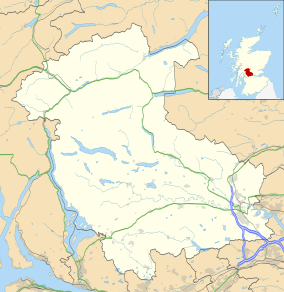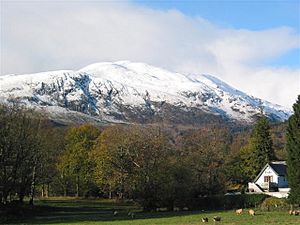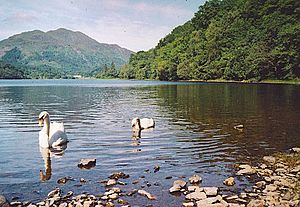Trossachs facts for kids
Quick facts for kids Great Trossachs Forest National Nature Reserve |
|
|---|---|
|
IUCN Category II (National Park)
|
|
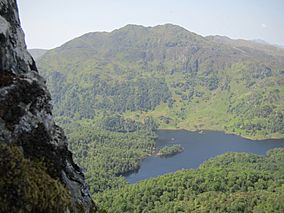
The forested area at the eastern end of Loch Katrine
|
|
| Location | Stirling council area, Scotland |
| Area | 165 km2 (64 sq mi) |
| Designation | NatureScot |
| Established | 2015 |
| Owner | Forestry and Land Scotland, RSPB Scotland and Woodland Trust Scotland. |
The Trossachs is a beautiful area in Scotland. It has many wooded glens (valleys), hills, and lochs (lakes). You can find it east of Ben Lomond in the Stirling council area. The name originally came from a small woodland valley. Now, it describes the whole wider region.
The Trossachs is like a mini version of the Scottish Highlands. Its forests are home to many different animals and plants. A lot of the Trossachs is protected. This includes the Great Trossachs Forest National Nature Reserve.
The Trossachs is part of the Loch Lomond and The Trossachs National Park. This park was created in 2002. Many people visit the area because it's close to big cities like Glasgow and Stirling. It's a great place for walking, cycling, and sightseeing. You can even take a fun boat ride on Loch Katrine. The old steamer SS Sir Walter Scott, built in 1899, still takes visitors out on the water!
The Great Trossachs Path is a famous trail here. It's 48 kilometers long. You can walk, cycle, or even ride a horse on it. The path goes from Callander in the east to Inversnaid on Loch Lomond in the west. It passes along the northern sides of Loch Katrine and Loch Arklet.
Contents
What's in the Trossachs?
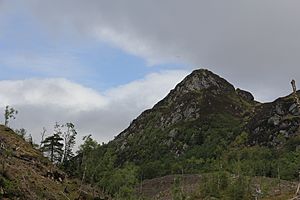
The main Trossachs valley sits between two hills: Ben A'an to the north and Ben Venue to the south. Loch Katrine is to the west, and Loch Achray is to the east. This valley is the heart of the region. The wider Trossachs area stretches out from here.
The A821 road goes through this valley. It's the main way to get into the Trossachs from the south and east. A part of this road, called the Duke's Pass, goes through Achray Forest. It reaches a height of 238 meters above sea level.
The towns of Callander and Aberfoyle are on the edge of the Trossachs. The only village of any size actually inside the Trossachs is Brig o' Turk. The Lake of Menteith is also nearby. It's a popular spot for fishing. On one of its islands, Inchmahome, you can see the ruins of Inchmahome Priory. Mary, Queen of Scots stayed here as a child for safety.
A Look Back in Time
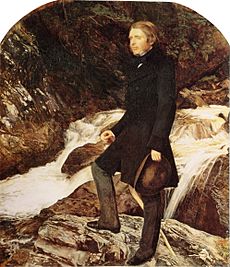
The Trossachs has a long history. People lived here even before recorded history. You can find ancient sites like marked rocks and old cooking mounds in Glen Finglas. There are also crannogs (ancient lake dwellings) on Loch Ard and Loch Venachar. An Iron Age hill fort called Dunmore also stands here.
The Trossachs became a popular place for tourists very early on. This was because of its beautiful scenery and its location. It's on the edge of the Highlands. The poet William Wordsworth and his sister Dorothy visited in 1803. Dorothy wrote about their trip in her book, Recollections of a Tour Made in Scotland.
The area became even more famous thanks to Sir Walter Scott. His 1810 poem, The Lady of the Lake, made the Trossachs very popular. The poem mentions many Trossachs places. The main character, the Lady, is found on Loch Katrine. Scott also wrote the novel Rob Roy in 1817. This book told the story of Raibert Ruadh, a famous cattle thief. He was born near Loch Katrine.
In 1853, the famous art critic John Ruskin and painter John Everett Millais spent a summer in the Trossachs. Millais started a painting of John Ruskin during this visit. Ruskin was very interested in the rock formations of the area.
The Trossachs Hotel was built on Loch Achray to welcome more tourists. Today, it's called Tigh Mor Trossachs and offers holiday apartments. In 1859, a dam was built at Loch Katrine. Aqueducts were added to supply water to Glasgow. Queen Victoria had a holiday house built overlooking the loch. It was called Royal Cottage. However, she never stayed there.
Nature and Wildlife

The Trossachs has both old, natural woodlands and commercial tree farms. The natural forests have mostly deciduous trees (trees that lose their leaves). The tree farms grow mostly conifers (evergreen trees like pines).
Many birds live in the Trossachs woods. These include black grouse, capercaillie, and goshawk. Mammals like red deer, roe deer, red squirrels, and pine martens also live here. Beavers have also been seen in the area. They likely spread from the River Tay.
The lochs are home to fish like brown trout, perch, and pike. You might also spot osprey and otters around the water. Some rare butterflies, like the pearl-bordered fritillary, have been found near Loch Katrine.
A large part of the Trossachs is protected. This helps keep its nature safe.
Great Trossachs Forest National Nature Reserve
The Great Trossachs Forest is a big project. It aims to create a 165 square kilometer forest. This forest will provide homes for many insects, mammals, birds, and other wildlife. Since 2015, the main part of the Trossachs, around Loch Katrine and Loch Arklet, has been a National Nature Reserve. It's called the Great Trossachs Forest National Nature Reserve.
This reserve is like a "forest in the making." It's managed by Forestry and Land Scotland, RSPB Scotland, and Woodland Trust Scotland. The goal is to create a varied landscape. This will help species that are rare in Britain. These include black grouse, golden eagle, osprey, wildcats, pine martens, red squirrels, water voles, and otters.
Other Protected Areas
A smaller part of the Trossachs is a Special Area of Conservation. This is because of its important native forests. The Trossachs is also a National Scenic Area. Scotland has 40 such areas. They are special places with amazing scenery that need protection. The forests owned by Forestry and Land Scotland in the Trossachs are part of the Queen Elizabeth Forest Park. The entire area is also inside the Loch Lomond and The Trossachs National Park.
Important Hills and Lochs
Here are some of the main hills in the Trossachs:
- Ben Venue (729 meters high)
- Ben A'an (454 meters high)
- Ben Ledi (879 meters high)
- Benvane (821 meters high)
- Ceann na Baintighearna (771 meters high)
- Stob a' Choin (865 meters high)
The major lochs (lakes) in the area are:
- Loch Katrine
- Loch Arklet
- Loch Achray
- Loch Venachar
- Loch Drunkie
- Loch Voil
- Loch Doine
- Loch Lubnaig
- Loch Choin
- Loch Dubh
- Loch Ard
The Lake of Menteith is also very close to the Trossachs.
Images for kids
-
Early morning view of Loch Venachar
See also
 In Spanish: Trossachs para niños
In Spanish: Trossachs para niños


